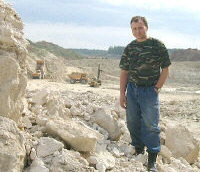Spicule-rich sediments of the Gzhelian
Photomicrographs by Dr. Yuri V. Yashunsky,
Aerogeologia, Moscow
The abundant silicified Gzhelian fossils
illustrated in the Gzhelian
Stage web site come mostly from the shale and limestone unit exposed
from 2 to 4 metres above the Kasimovian-Gzhelian stage boundary in
the Gzhel quarry section. These fine-grained sediments are silica-rich,
containing abundant isolated sponge spicules of silica composition.
Many sponges contain spicules made of silica, so when the animal
dies the spicules are released from the sponge tissue and accumulate
in the sediment. There are also some complete sponges present, like
the Pemmatites shown on the fossil pages, that have a skeleton of fused
silica spicules arranged in a network. The abundance of sponge spicules
suggests that the seafloor in this area was covered with sponges, like
a sponge garden.
Commentary, by Yuri Yashunsky
Analyses of polished rock sections from Unit 10 show
that sponge spiculas
of all types are composed of chalcedony silica. Opaline biogenic silica
(which can be readily detected in polarized light because of its isotropism)
was not detected. These observations are in good agreement with
observations that opaline biogenic silica of sponge spicules is not present
in Paleozoic deposits. During recrystallization, opaline biogenic silica
passes first into chalcedony and then (sometimes) into quartz.
As can be seen from the samples and polished rock
sections, the biogenic
sponge spicules of the carbonate layers in Unit 10 did not experience
dissolution after their burial. Their surface is smooth and structure details
of very small size still can be seen on the surface of the spicule. The
surfaces of rounded detrital sand-size quartz grains in Unit 4 and above
also show no evidence of dissolution of silica. You get the impression
that all of the silica that replaced carbonate skeletal remains and forms
chalcedony nodules has come from outside sources, not from the spicules
of these rock samples.
Discussion:
Sponge spicules are formed of biogenic silica, a type of silica that is poorly
crystallized. Biogenic silica is easily altered or dissolved. The sponge spicules
shown here have recrystallized to normal quartz, preserving them in their
varied shapes. The process of dissolution of biogenic silica releases silica
ions to fluids circulating through the sediments, providing a source of silica
that can replace carbonate skeletons of other fossils. The process of
silicification often preserves very fine details of the original carbonate,
yielding beautiful fossils that can be separated from the matrix.
Sponge spicules have an important role in providing
silica ions that replace
carbonate minerals in fossils. In some sediments, biogenic silica is often
completely dissolved and the silica (as ions in solution) migrates to other
sites. This dissolved silica then precipitates and forms chert nodules or
replaces carbonate fossils, or both. In offshore, quiet water environments
with a mixture of clays and carbonate present, sponge spicules often form
a large part of the sediment, indicating an abundance of sponges present
in the environment.
Tom Yancey
Top
of Page
Site Search
Engine
search Carboniferous fossils of Russia or the Web
Site Links
Stratigraphy
and Sediments
Gzhel
quarry, Gzhel village
Pennsylvanian
Gzhel quarry, Gzhel village
Mississippian
Visean Stage, Aleksian-Mikhailovian substages

Home Page
Carboniferous fossils of Russia
The Pictures on this web site
are the sole
and personal property of Dr. Alexander Davydov
and Barry Sutton. Unauthorized use of any
picture(s) on this web site is Strictly Prohibited.
© All rights reserved
Contact:
Barry Sutton and Alexander Davydov
Russia@LakeNeosho.org






